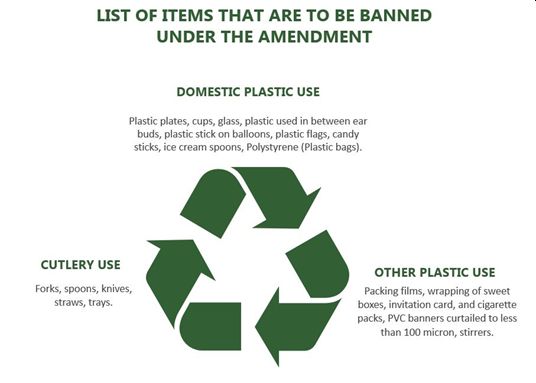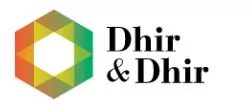Analysis of EPR GUIDELINES, 2022 under The Plastic Waste Management (Amendment) Rules, 2022
Early this year, the Ministry of Environment, Forest, and Climate Change (MEFCC) published Guidelines on Extended Producers Responsibility (the Guidelines) on plastic packaging. The Guidelines have been introduced through the Plastic Waste Management (Amendment) Rules, 20221 and are set to come into effect from July 1, 2022. It imposes a ban on certain single-use plastic products having low utility and high littering potential. Its illustrated in the below diagram:

In lieu of "Azadi ka Amrit Mohatsava" and to curtail pollution caused by the unmanaged plastic wastes generated across the country, the Department of Forest and Climate Change and the Government of India published the Plastic Waste Management (Amendment) Rules, 2021 (Amendment) on 12 August 20212. Ban will be imposed on the plastics that are lesser in
utility, but have high chance in littering. India had set a resolution on addressing the worldwide issue of Single Use Plastic (SUP) and the consequences that are affecting nature at large, at the 4th United Nation Environment Assembly (UNEA 4). The session at UNEP 5 conducted in March 2022 concluded constructively of taking robust action on banning specific list of plastics.
As per the data by Central Pollution Control Board (CPCB), about 200 brand owners, including numerous MNCs, and 26 plastic importers have registered for the Extended Producer Responsibility (EPR) for plastic packaging under the updated Plastic Waste Management Rules 2016 prior to the complete ban on SUP commencing from July 1, 2022. Additionally, 198 brand owners (BOs), 26 importers (Is), and 29 producers (Ps) have enrolled under the PIBO (Producer, Importer and Brand Owners) registration for the years 2022-2023, and 76 BOs, 17 Ps, and 38 Is have already filed their registration forms.
This article explains the meaning of EPR and its importance in the current times. Furthermore, the article also provides an overview of the Guidelines along with the major changes.
1. EPR- Meaning and Importance
EPR is an environmental protection strategy where the manufacturers and importers take responsibility and onus of the environmental impacts of the products that they are manufacturing or importing all throughout the product life cycle. EPR is the producer's agreement to support a reverse collection system and recycle end-of-life, post-consumer waste. The goal is to recycle the trash back into the system in order to recover the resources it contains.
It is impossible to overstate the value of EPR in a society where waste production increases daily. In fact, it plays a significant part in both the circular economy and the zero-waste paradigms, two of the most cutting-edge approaches to waste management currently in use. EPR programs may not necessarily need to be intricate, expensive, or even particularly inventive, depending on the kind of product one is working with.
Examples of EPR that are straightforward but have been successful in many locations including container take-back initiatives include recycling programs and bringing own bags/containers for shopping etc. Most of the time, when products are purchased by customers (often beverages), a nominal deposit is made; this deposit is then reimbursed when the shop receives the packaging debris. There are currently 10 states in the US that are enforcing container deposit regulations developed by local government, and this establishes a legal obligation on the store to take back containers for recycling or reuse.
Other nations have more complete versions of this system, where containers are returned to the manufacturer to be cleansed and reused. Germany, for instance, provides single-use deposit (Einwegpfand) and reusable deposit choices for recyclable containers (Mehrwegpfand). Consumers are discouraged from buying reusable deposit containers because they cost substantially less upfront than single-use ones. Reusable items are taken out of the trash stream by the manufacturer after being returned and are then given back to the store to be sold once again.
2. Overview of the Guidelines
2.1 Applicability: The Guideline will be applicable to Producer, Importer, Brand Owners and Plastic Waste Processors.
2.2 Categories: The Guideline covers 4 categories of plastic packaging under EPR. Those categories include Rigid Plastic Packaging, Flexible Plastic Packaging, Multilayered Plastic Packaging and any other Plastic Sheets. The division of plastic packaging into four categories will make it easier to distinguish between them and manage them accordingly.
2.3 Mandatory Registration: Every entity on which this Guideline is applicable, is obligated to get the registration from CPCB through an online centralized portal. If the entity is working in more than one state, the registration will be done by the State Pollution Control Board or Pollution Control Committee through the centralized Extended Producer Responsibility portal.
The link for the CPCB portal is:
2.4 Well defined EPR Targets: The Guidelines provide EPR targets for Producers, Importers, Brand Owners and Plastic Waste Processors. These targets include the following components:
- EPR Target (Percentage wise);
- Recycling Obligation;
- End-of-life Disposal; and
- Obligation to use Recycled Plastic Content
2.5 Imposition of Environmental Compensation: Environmental Compensation will be imposed with regard to the non-fulfillment of Extended Producer Responsibility targets by Producers, Importers, and Brand Owners, be based on the polluter pays principle in order to protect and improve the quality of the environment as well as to prevent, control, and abate environmental pollution. There is a provision for carrying forward the unfulfilled EPR Targets to the next year for a continuous period of 3 years.
2.6 EPR Committee: To propose measures to the Ministry of Environment, Forest and Climate Change for effective implementation of EPR, including amendments to Extended Producer Responsibility guidelines, the Central Pollution Control Board will form a committee under the direction of its chairman. The committee will keep an eye on how EPR is being implemented and will also take any necessary action to resolve any issues. The Committee will also be responsible for overseeing and directing the online portal, including the approval of necessary forms.
3. Major Drawbacks of the guidelines
3.1 Absence of mechanism to achieve targets: Given that such goals heavily rely on efficient garbage collection systems, there is no discussion of the strategies to do this within the suggested time range. If this depends on an independent collection process led by the manufacturers and brand owners, it will result in redundant collection mechanisms, which would be ineffective and run the risk of eliminating thousands of jobs that are already part of the current system.
3.2 Lack of Supply Chain Management: The environmental compensation scheme and the surplus EPR certificate offsets may be the most divisive part of the Guidelines. Due to their complexity, offset systems require a reliable reporting and monitoring mechanism. Annual reports on their goals are required to be submitted to an internet site by Producers and Brand Owners. There is no provision for an independent audit or verification of these annual reports by a third party. There is no known instance of an effective trust-based governance project in India, which raises various questions about the effectiveness of such a system for keeping track of plastic garbage.
3.3 Exclusion of Informal Sector: The Guidelines also appear to be in odds with the aims for participation of the informal sector. Only registered recyclers and processors are permitted to provide certifications under the EPR system of certification, which has been linked to a formal recycling system. By doing this, the nation's labor force which is the foundation of recycling sector, is completely abandoned.
4. Conclusion
The Guidelines are a mixed bag of its own pros and cons. Though it has its own drawbacks in the process of implementation, it is still a big step towards a regularized Plastic Waste Management System. We no longer have a choice under the linear economy model, which is built on the 'take-me-use-dispose' premise. A sustainable answer is the circular economy model, which is founded on the 'take-make-waste' methodology. The natural environment is restored, materials and goods are used as long as feasible, and trash is managed sustainably under the circular economy concept. Resources are not thrown away or destroyed at the conclusion of the process; instead, they are recycled, mended, remanufactured, or reused while still having value. We must establish a strong system for managing plastic trash if we are to preserve our resources, safeguard our environment, and preserve our ecology, as plastic poses a serious threat to our biodiversity. These Guidelines are definitely a positive step towards a circular economy.
The purpose of amendment, is to serve a good ecological balance to the surrounding and eliminate in stocking, sales and distribution of SUP that affect our environment in various harmful ways. Resolute steps have been taken by Government of India to mitigate the plastic usage and efforts are made to find the best alternative for the same.
EPR will be implemented via a customized web platform, which will serve as the system's digital spine. Through online registration and filing of annual returns, the online platform will enable tracking and monitoring of EPR obligations and lessen the compliance burden for businesses. The recommendations have outlined a framework of business auditing and verification in order to assure monitoring of EPR responsibilities.
Footnotes
1. https://egazette.nic.in/WriteReadData/2022/233568.pdf
2. https://pib.gov.in/PressReleasePage.aspx?PRID=1837518
This article is for information purpose only. It is not intended to constitute, and should not be taken as legal advice, or a communication intended to solicit or establish commercial motives with any. The firm shall not have any obligations or liabilities towards any acts or omission of any reader(s) consequent to any information contained herein. The readers are advised to consult competent professionals in their own judgment before acting on the basis of any information provided hereby.


